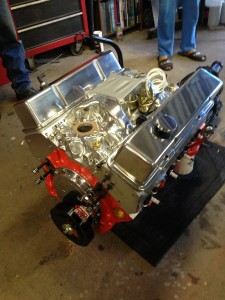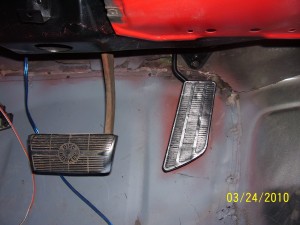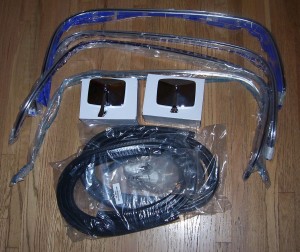So I really want to go more in depth on the gauge work that I did – because it was a LOT of work, and I really like how it turned out. So I want to be sure and document it.
The basic issue was that in my original cluster I had a speedo, a fuel gauge, a clock (that didn’t work), a temp (that didn’t work) a voltmeter and an oil pressure (that – you guessed it -didn’t work). But that isn’t what I WANTED! And also, they looked old and nasty. So I thought to myself, “Well, how hard could it be to just modify the gauges from the cluster to replace the non working ones, and to move the fuel gauge to the smaller location? And while I’m at it migrate a tach into the slot where the fuel gauge USED to be? And design new faces for all the gauges too!”. The answer is very very very hard.
I created new gauge faces by taking LOTS of measurements, and plugging everything into Illustrator and designing a whole new matching set of gauge faces. I printed them out on photo paper and used a craft knife to carefully cut them out. When each gauge face was prepped properly, I used double sided adhesive to stick them in place. As I’ve mentioned before I will probably have to go back and replace them with vinyl printouts because the paper curls in high humidity.
I first had to chop the cluster housing all to bits. Then cut up the original gauges. First I cut out the old parts to the clock and threw them out. Then I took the fuel gauge internals and cut them off the large face they were on, and moved them behind the old clock face and epoxied them in place. That took about 5 hours because it involved a lot of tiny-part-fabrication and lining things up over and over and over. On top of that, I had to create and entirely new needle for the fuel gague – the old one was way too big, and the needle from the old clock wasn’t the right size or shape at all. So I made a new needle out of lexan and painted it to match (it came out really well too – you can’t even tell) I was able to test the fuel gauge out and position the new needle correctly by using a 9volt battery and a 90 ohm resistor. The three poles on the back of the fuel gauge are a positive, a negative and a signal line. If you place a 90 ohm resistor in the right place, and then test it with the circuit completely open, you are basically simulating the sender unit. So you can go “Ok – it should read FULL now” and then position the needle accordingly.
I then moved on to the oil and temp gauges. I ripped them out of a sunpro gauge cluster. I cut out the old internals for the original gauges and mounted the sunpro internals behind the faces taking care to line everything up right. This was a royal pain in the arse, but when it was all said and done everything lined up well. I placed in their new faces and tested them out and positioned the needles. To calibrate the oil pressure gauge I created a small pressure chamber out of a section of PVC pipe with a schrader valve and a port to screw in the oil pressure lead. I also added an additional PSI gauge into the chamber. I then used a hand pump to pump the chamber to given pressures (20, 40 , 60, 80) and made sure the needle on the new frankengauge matched the ones on the hand pump and the additional pressure meter. Amazingly, I got it on the first try. They all pretty much matched up. To calibrate the temp gauge, I brought some water on the stove up to various temperatures and put in the temp probe. Needle placement was pretty easy!
Then I cut up the sunpro tach and mounted it in behind the old fuel faceplate. That required a looot of plastic surgery, but it turned out well.
I wanted new lighting too, so I created a network of red LEDs on the interior of the gauge shroud. It took a lot of trial and error to get everything to fit back together with the added bulk. I then did some major wiring to the back circuit to get everyone routed to their new homes. I then installed the new cluster and routed the new temp line and oil line to the engine.
ALMOST everything worked. The tach didn’t work at first because the ground had been cut by the guy who did the floor pans. After hooking it back up though, it was fine. The LEDs didn’t work because the sot I wired them into had some sort of issue – so I had to rewire them to a different bulb feed. The fuel gauge jumped around because it had a short. But ofter sorting those things out, everything seems rockin now! Plus the lights look really nice.
So yeah. Lot of work but really really worth it.
The other thing I’ve gotten done recently is new shock absorbers. The truck was really bouncy. So much so that it felt unsafe. So my buddy James came over and we tackled putting in a new set of shock absorbers. Took about 6 hours for all four – but most of that was trips back to O’Reilly’s for sockets and wrenches. I ended up having to buy a new socket and 2 new wrenches AND a new set of extensions. I swear every single bolt had a different sized head. I put Monroes in the front, and would have put them in the back too – but O’Reilly’s only had the one set in stock. So I had to go with the cheapos in the rear. I may change those out again before too much longer while all the hardware is still fresh.
Lemme tell you – new shock absorbers make all the difference in the world. The ride is totally different. I was shocked (hah!). Much easier handling – and it feels more real somehow. Much more like a vehicle and less like a deathwagon. I can seriously see after I get the interior done and finishing out the suspension and steering gear box wanting to drive it every day. Ok, and replacing the windshield. And mirrors. And weatherstripping….
 Well, it’s been busy around here. I spent the last few months finishing out our metal building as my new workshop. That involved a lot of spray insulation, paint, construction, electrical work, and creative waterproofing. I now have 10 new outlets on a new 50amp circuit and new breaker box, an insulated workplace and some good organization. I did all this so that I could move all of my tools from our downstairs garage up to the new workshop to create space for the truck. When the truck gets back from paint (which will hopefully be very soon) I will park it in the downstairs garage where I can pull the engine, install the new AC components and strip and paint the engine compartment. The engine is pretty much done! As soon as the engine compartment stuff is finished, I should be in the home stretch.
Well, it’s been busy around here. I spent the last few months finishing out our metal building as my new workshop. That involved a lot of spray insulation, paint, construction, electrical work, and creative waterproofing. I now have 10 new outlets on a new 50amp circuit and new breaker box, an insulated workplace and some good organization. I did all this so that I could move all of my tools from our downstairs garage up to the new workshop to create space for the truck. When the truck gets back from paint (which will hopefully be very soon) I will park it in the downstairs garage where I can pull the engine, install the new AC components and strip and paint the engine compartment. The engine is pretty much done! As soon as the engine compartment stuff is finished, I should be in the home stretch.
